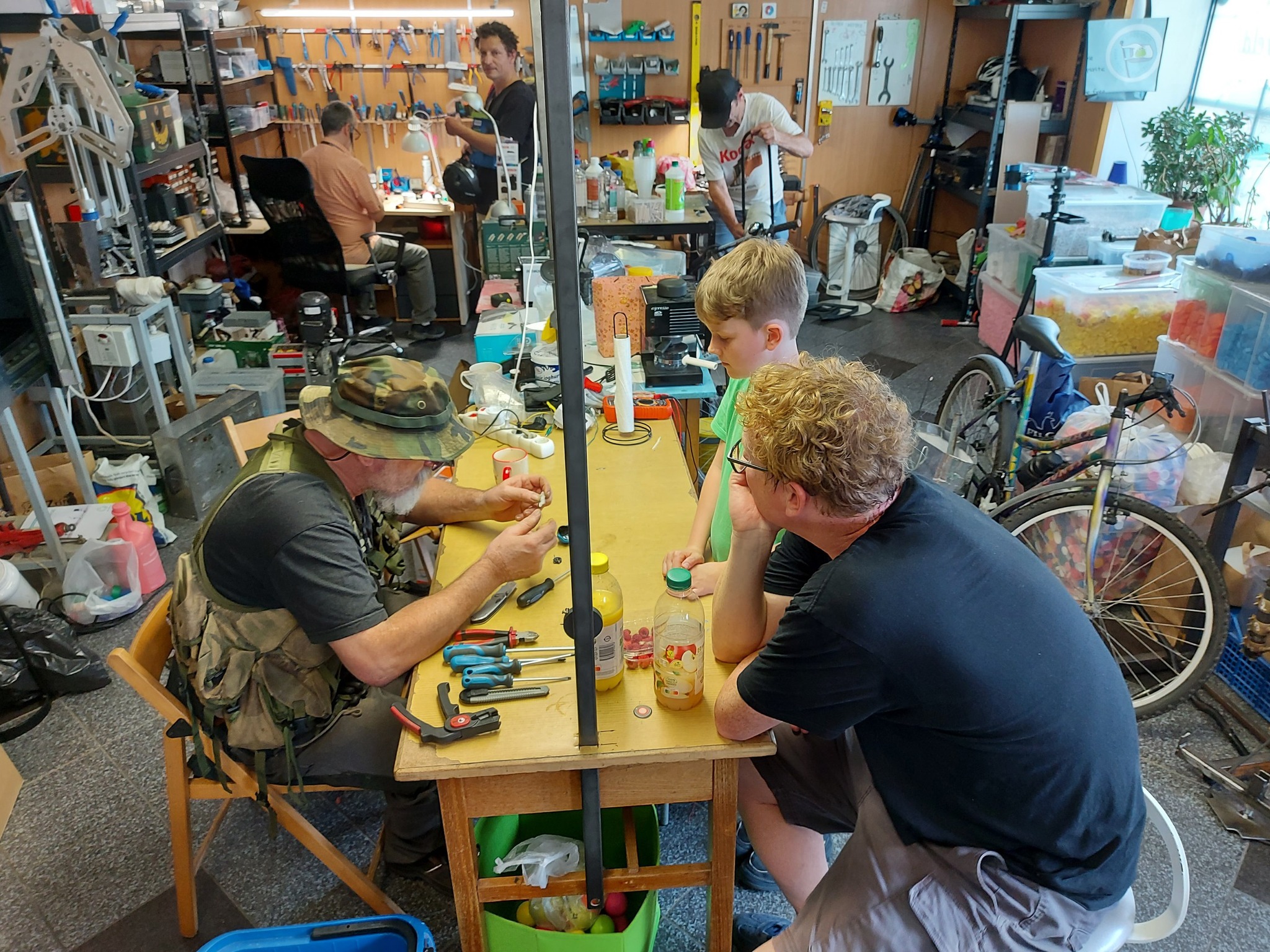Repair Café Budapest is Hungary’s first and only repair café, offering a collaborative space where broken household items—like toasters, bicycles, and sewing machines—are brought back to life, and where people gain confidence through learning to repair objects. Located in one of Budapest’s most disadvantaged districts, Józsefváros, the café combines environmental awareness with community-building, welcoming everyone from elderly locals and hobbyists to people with cognitive disabilities or housing difficulties.
In this interview, founder Noémi Gégény shares how the initiative began with a spark of inspiration, which led to securing a low-rent municipal space, and eventually grew into a fully functioning repair hub with support from Budapest’s Participatory Budget. She discusses the practical and social aspects of repair, the challenges of running a non-profit with minimal funding, and the unexpected ways in which the café has become a trusted neighbourhood anchor.
What inspired the creation of this space, and how did the idea evolve from concept to reality?
The inspiration for this space came from a Dutch initiative called Precious Plastic— a decentralised, open-source plastic recycling network. We began working with it around six years ago through the Para-fitt Association, which supports the mental and physical rehabilitation of children and young people with intellectual and multiple disabilities. At the time, we were based in a different workshop. Precious Plastic’s practical, hands-on approach to turning plastic waste into useful objects immediately resonated with us.
Our involvement with Precious Plastic connected us with the Dutch embassy where we got introduced to a wide range of innovative Dutch concepts such as the Repair Café. It offered a way to bring people together to fix things, share knowledge, and reduce waste — values that aligned perfectly with our existing work.
When we saw an opportunity to apply for a municipal space through a call by the Józsefváros Municipality — where civil groups can rent at favourable rates — we jumped at it. Initially, we wanted to move our Precious Plastic workshop there, but we also knew that if we got the space, we would try to bring the Repair Café concept with us. From the beginning, these two ideas were connected in our minds: creative recycling, practical repair, and inclusive community activity all in one shared environment.
How did the Repair Café secure its initial funding and support, and what challenges did you face in getting it started?
Once we secured the space, we submitted the idea for Repair Café Budapest to the City of Budapest’s participatory budgeting program in 2021. The public response was amazing. In the next year’s voting round, the project was selected as a winner, receiving a HUF 50 million (approximately €125,000) budget from the city to fund three years of operation and the necessary equipment.
But it’s important to know that even if your idea is chosen, that doesn’t mean you automatically get to carry it out. The city opens a public procurement process, and the originator — like anyone else — has to apply to implement it. In some cases, the city may decide to implement the idea themselves, involving the originator only in planning discussions. So, even after our idea won, we had to compete in the tender like everyone else.

We were prepared, though. We had already secured the space, developed the concept, and started gathering the professionals we’d need to run it. That preparation paid off — we won the tender. After that, the real work began: renovations, equipment sourcing, setting up the team. From the moment we submitted the idea to when the café finally opened, it took about two years of planning, building, and follow-through. Knowing it was funded by and for the community made it especially meaningful. The project became a true reflection of civic participation.
How do Precious Plastic, the Repair Café, and Para-fitt SE all connect in your work?
They’re all part of a broader philosophy we’ve been building at Para-fitt SE: giving people with intellectual disabilities meaningful ways to participate, create, and connect. Precious Plastic was a turning point for us. It allowed our participants to make things with their hands, explore creative ideas, and recycle materials that were freely available. And it wasn’t just about plastic. It became a workshop space where we could do all sorts of things — from making crafts to cooking meals and even playing board games. These moments of shared activity are incredibly valuable.
That idea of combining everyday experiences with skill-building and creativity came to life most vividly during Covid. At the time, our Precious Plastic workshop was in the basement of our apartment building. While the rest of the world was in lockdown, this space became a safe little bubble. We’d go down there, cook together, tinker with materials, and yes — we all wore five masks. But even with restrictions, we had a place to be together and keep going.
When we moved to the new space, it felt only natural to add the Repair Café alongside. It shares the same values — reuse, learning, doing things with your hands. The repair shop concept fit right in. Environmental awareness is still developing here, but these kinds of programs — especially when done through inclusion and community — help build that culture from the ground up. It all happened organically. One thing led to the next, and now we have a space that’s not just about repair or recycling, but about real, lived connection.
The Repair Café as you said is much more than a repair and recycle space.
This space isn’t just a workshop — it also serves as a community hub. We regularly host workshops here, including Precious Plastic activities with children who have cognitive challenges, and we’ve even celebrated birthdays in the space. It’s very flexible — we simply rearrange things based on the activity. That’s one of its strengths: it can easily adapt to both structured programs and casual gatherings.
In addition, we operate as a donation point. Since we’re not a store, we don’t sell anything. People drop off items — clothing, household goods — and others are welcome to take what they need. This started organically, not as a planned initiative. People just began showing up asking, “Can I leave this here?” or “Can I take this?” and it naturally became part of our space’s function.
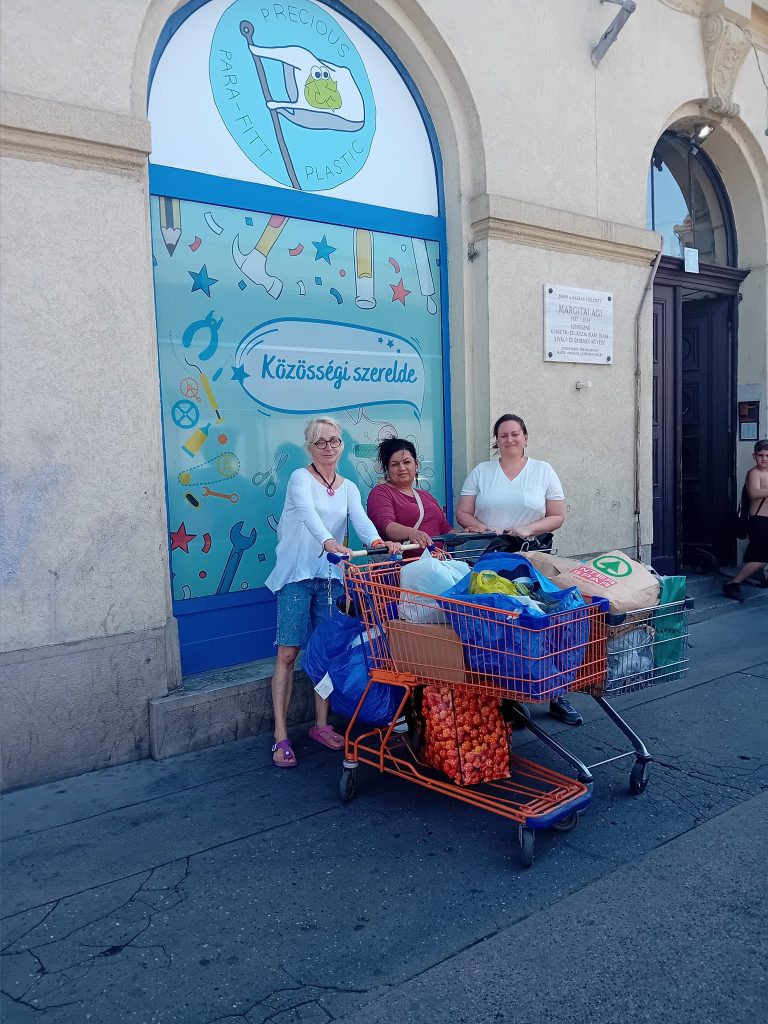
Around the time we moved in, the 8th district launched a volunteer initiative at the Alföldi Street homeless shelter. We got involved — even bringing along the children we work with. That’s when the donation activity really took off. We began collecting items the shelter needed. Over time, more donations came in — including things not suitable for the shelter but still useful. So, we started sharing them with local residents. It just grew from there.
Can you tell us more about the people who do the repairs?
The team currently includes four people: a general technician, a bicycle repairer, an electronics repairer, and a seamstress. Each person brings their own skills, which allows us to handle a wide range of repairs — from household appliances to bikes and textiles. I work more in the background, helping with coordination.
Many of the people involved aren’t here primarily for the income. Some have full-time jobs or run their own businesses, but they still choose to spend time here because they enjoy the atmosphere and want to contribute.
One of our technicians, Gyula — known for his Indiana Jones-style hat — comes in almost every day, far more than we can pay him for. He enjoys the work, the space, and the sense of purpose. It’s similar for others on the team. This isn’t just a job for them; it’s something they genuinely care about.
How did you find the people who are now part of the team?
They were already around by the time we were getting ready to open. We put out a questionnaire on Facebook asking who would be interested in joining. We asked people to let us know if they wanted to volunteer — or, if not, what hourly rate they would expect, how many hours they could commit to, and with what regularity.
We processed all the responses. Some people joined the team then and there. Others were recommended by acquaintances, and a few simply walked in off the street. They saw what we were doing, got curious, and asked questions.
What kind of items do people bring in most often? Are there any that have surprised you?
There’s always something surprising, yes. But what we see most is electronics — small household appliances: blenders, toasters, coffee machines — those are typical. Even children’s toys come in. Basically, people bring in whatever they can carry.
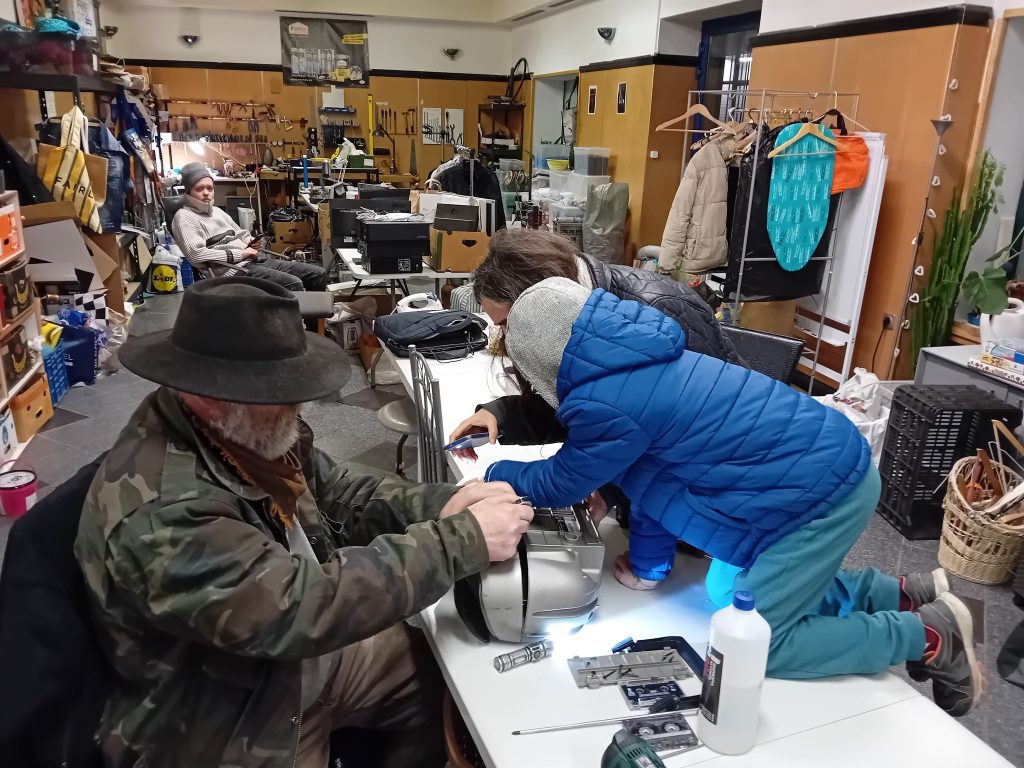
If we had more capacity — even something as simple as a car — people would likely bring in larger items like refrigerators or washing machines. I was recently looking into how repair cafés operate in Austria, and their system is remarkably well developed. They’ve introduced service vehicles that allow them to collect and deliver items, and their entire operation is impressively organised. Some even have dedicated shops.
We’ve considered adopting a similar model, particularly the idea of selling unclaimed items after repair, which in some countries helps sustain these kinds of spaces financially. But the reality here is different. This neighbourhood isn’t the kind of place where people come to buy refurbished goods. Instead, they come to fix what they have — or to get help doing so.
What’s the process for getting something repaired here — how does it actually work when someone wants to bring in an item?
People who need something repaired do need to register. We have a Google spreadsheet that’s connected to our mailing list, and we use a shared email account that everyone on the team can see. There’s also a Google Calendar where we track bookings, so we don’t overlap or overbook each other.
Some people come in and register in person, but they can also do it through Facebook — we use Messenger too. Still, the best way is by email. If someone sends a picture of the item, it really helps. That way the team can see right away whether it’s something they can fix.
After that, they come at the agreed time. We never just take the item and fix it for them. That’s not how this place works. They do the repair together with one of the team — that’s part of the concept. It’s meant to be collaborative, and often, people learn something in the process.
When people come in and ask if they can leave something to be repaired, we explain that it doesn’t work that way, and instead, they need to repair it together with one of our team members. The whole process is collaborative, and the goal is for visitors to learn something while fixing their item.
Even learning a small skill can be meaningful such as for an older gentleman who recently learned how to reconnect a loose wire using a soldering iron, guided by Andris. He was so proud, he asked us to take photos and videos to show his family, joking that they wouldn’t believe it otherwise. Similarly, a grandmother visited with her grandchild, and they worked together on a small electrical repair. That workstation has become particularly popular because people enjoy learning, and Andris enjoys teaching them.

The sewing process works similarly: visitors take apart their broken items, and the seamstress guides them through repairs. Some people specifically want to learn how to use a sewing machine, while others already know and just need a space to work. In those cases, we simply arrange a suitable time, asking only that they leave everything tidy afterward and avoid busy hours.
We also have visitors who come specifically for bicycle repairs or just to use tools independently. This flexibility is part of what makes the Repair Café work well, whether visitors want close guidance or prefer to quietly fix things themselves.
Is this collaborative model, with people fixing things together common in the Repair Café model internationally?
It’s actually very typical of Repair Cafés everywhere—not just here. The core concept of repairing together, collaboratively, is something you’ll find in almost every Repair Café abroad. Another key element is that it’s free.
One main difference abroad, though, is that people usually volunteer completely—they’re not compensated, which keeps operating costs very low. Our model here involves some payments to staff on a commission basis, which is different, but the spirit of collaboration and openness is the same everywhere.
Who are the people who typically come here to get things repaired, what motivates them?
We have a diverse group coming here, and their motivations vary. Younger people and foreigners typically come because they care deeply about sustainability and the environment. For them, repairing items is part of a conscious lifestyle choice—they want to avoid unnecessary waste and believe strongly in reusing items rather than throwing them away.
Older visitors, on the other hand, often come due to financial necessity. Many of them simply can’t afford to buy something new or pay for professional repair services. For example, we recently had an older woman bring in a blender that was over 40 years old, which she used regularly to prepare food for her husband. The blender was in very poor condition, but it was still working, and replacing it wasn’t an option for her. She was incredibly happy when we were able to help her fix it. In fact, she returned the very next day with three more blenders. Her story stuck with us, and we even shared it online, because it highlighted just how significant this service can be for people in financial difficulty.
In addition to repairing things and teaching people practical skills, you’re also clearly doing social work here — creating a safe space, building community. Is that something the municipality recognises?
Yes, I feel it’s a form of social work, absolutely. But officially, that’s not what the project is labelled as. It’s not considered the main purpose, even though we can all see the social impact it has. People don’t just come here to fix things — they also come to talk, to be in a warm and welcoming place.
I think the municipality sees the value in it, even if they don’t visit regularly. From time to time we get feedback, usually second-hand, that they’ve heard good things about us. Someone will tell them, “So many people speak well of the Repair Café,” and they pass that along to us. The feedback we receive is generally positive, even if it’s not formal.
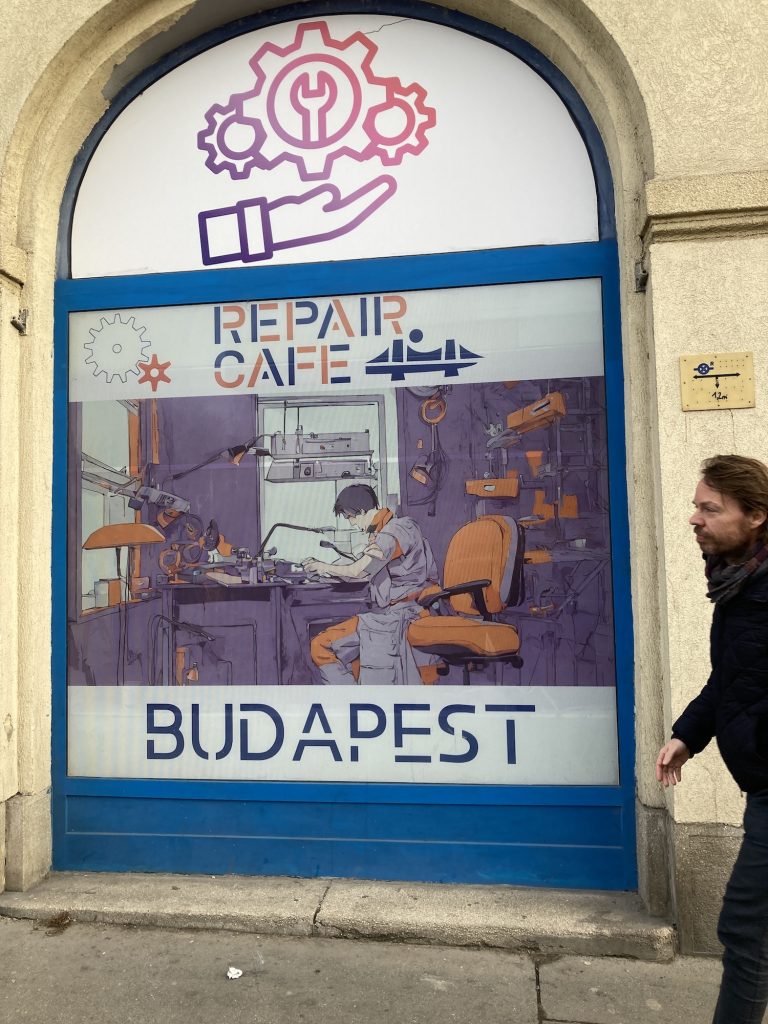
We’ve been in the local newspaper once or twice, and there’s been some visibility. Recently, a district resident even offered to print flyer templates and distribute them in apartment buildings — specifically to reach older residents. Among the elderly, word of mouth is very important. Someone hears about it from a friend, or on the radio, and they come in. We’ve been on the radio a few times, and that seems to really reach people. We usually jot down their phone numbers in a red notebook so we can follow up later — call to confirm a time, or check in if they haven’t come by.
This area used to have small repair shops — upholsterers, electronics shops. Do you have any relationship with those older local services? Could there be cooperation?
We haven’t really made contact with them. I’ve always meant to go visit the TV and antenna repair shop nearby, but I haven’t gotten around to it. There used to be a sewing machine repairer round the corner but we found out he had already passed away.
If someone brings in something specific that we can’t fix — like an old CRTTV — we try to redirect them. We know what services still exist locally and we send people there if it’s outside our scope. For example, we don’t do upholstery at all. But of course, it’s also a question of whether our free service is unintentionally competing with them. We don’t charge any inspection or handling fees, only the cost of a part if it needs replacing.
Often, people bring things that service shops have already rejected — items they’ve been told to throw away, things other places say aren’t worth fixing. And we manage to repair about 70–80% of those. So in a way, we’re complementing what’s left of the old repair economy — people come to us when they’ve already been told there’s no hope.
You’re a trained special needs teacher and swimming coach — but here you seem to be doing much more. What roles are you actually juggling to keep this place running?
Managing the Repair Café wasn’t originally part of the plan. When we created the initial budget, we included funding to hire a coordinator, but the position offered only HUF 120,000 (around €300) for a part-time, four-hour-a-day role. We did find someone for the job, but they left after just two days. Since I was already here, I decided to take it on myself.
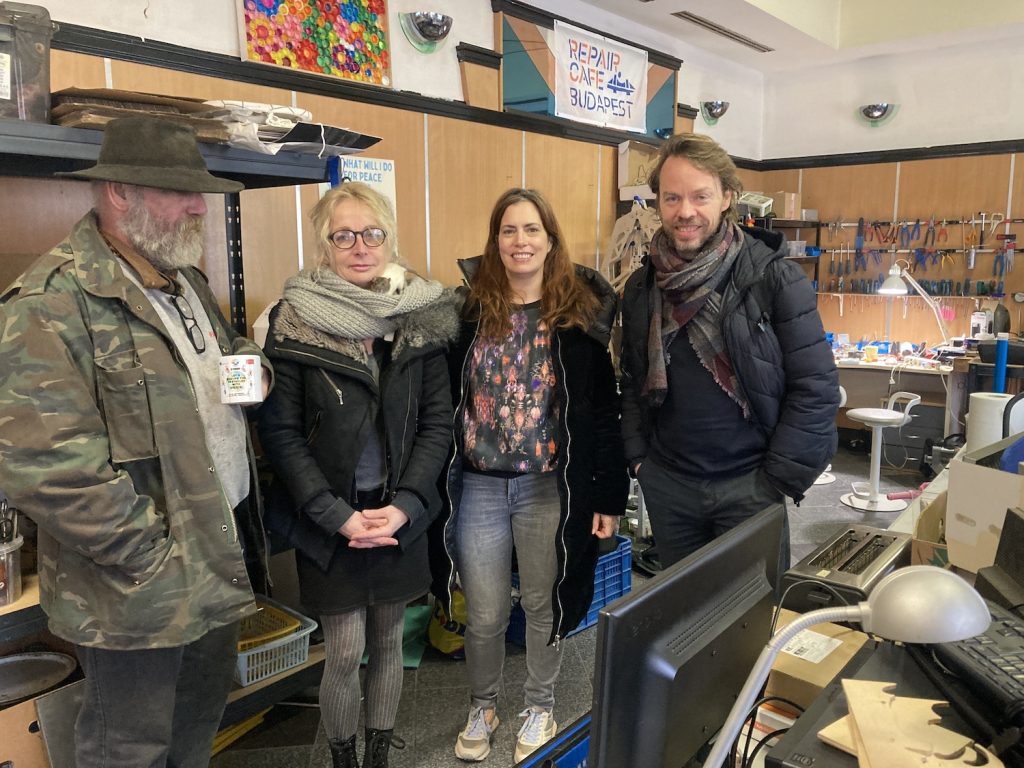
And that’s how I ended up running the place — still for the same salary. The role isn’t about knowing how to do repairs; we have professionals for that. What matters is keeping everything running: managing the space, welcoming visitors, maintaining the calendar, responding to messages, and making sure nothing falls through the cracks.
I also coordinate volunteers, even though we’re technically too small to have a formal structure for that. But it’s necessary, and fortunately, we have people we can count on — volunteers and helpers who step in when needed. The truth is, we’ve already grown beyond what we originally planned for, and now the real challenge is figuring out how to sustain it all once the current funding runs out.
What are the financial realities behind the scenes? Have you found a path toward long-term sustainability?
It’s a challenge, always. A lot of people have contacted us saying they want to open a Repair Café of their own, and I always say: that’s great — but first figure out how you’re going to fund it. For us, the costs are around HUF 800,000 to 900,000 per month (€2000-2300), depending on the season. That covers everything — utilities, team members, the space. It’s really not much for what we do, but earning that amount consistently is no small thing.

We’re still within the funded period, with two years left of support, so we’re not running it as a business. But of course, we’re thinking about sustainability. Precious Plastic could become one income stream. We also recently joined the Civil Impact Academy — that’s where non-profits and companies are brought together to see how they can work together.
But the bigger dream is to partner with companies that make household appliances — because a project like this fits perfectly with their corporate social responsibility. Especially now that EU regulations require longer warranties on appliances and parts. Support from those companies would cost them very little, but mean a lot to us — and the PR value for them could be significant. The hard part is building those connections.
What kind of longer term guarantees do you have for your operations, based on your current funding?
We’re currently supported in two ways: one is the low rent from the 8th district, and the other is the funding we receive from the central municipality of Budapest. Our lease in Józsefváros is for five years, and the city funding contract is for three. But there are complications. The grant budget, for example, sets a fixed percentage for utilities — and that’s nowhere near enough to cover the real cost. We’re only allowed to spend about half of what we actually need on water, electricity, and heating.
And because we’re not on residential rates, we pay three times the regular cost. So yes — the utility expenses are much higher than expected, and we don’t have the freedom to adjust the budget accordingly. It’s one of those rigid rules that don’t reflect the actual conditions — a very familiar kind of problem here.
Your Repair Café is very popular—in person, and also on Facebook. What do you think is behind its success? What makes people so eager to come here?
I think a big part of it is the opportunity for people to come together and actually do something meaningful. They don’t just drop something off to be repaired—they participate, they learn, they engage. It’s a shared experience, and people genuinely like that sense of involvement and community.
Just recently, for instance, we accidentally overbooked ourselves. I had started writing appointments down for Andris on a paper calendar, thinking the schedule was clear, but by the time I wanted to fill in the online calendar, I saw he had already booked appointments there. People kept showing up, and we suddenly had a lot of visitors at once. I tried my best—“Coffee? Cookies? Should I put on some music? You’ll have to wait a bit”—and to my surprise, nobody minded. They sat down, started chatting with each other, and genuinely enjoyed the atmosphere. I apologised at least five times, but everyone reassured me it was fine. They were comfortable just talking and being together. That showed me again how important the social aspect is. People like feeling welcome, taken care of, and connected. The fact that they can get something fixed is almost secondary to the experience of community.
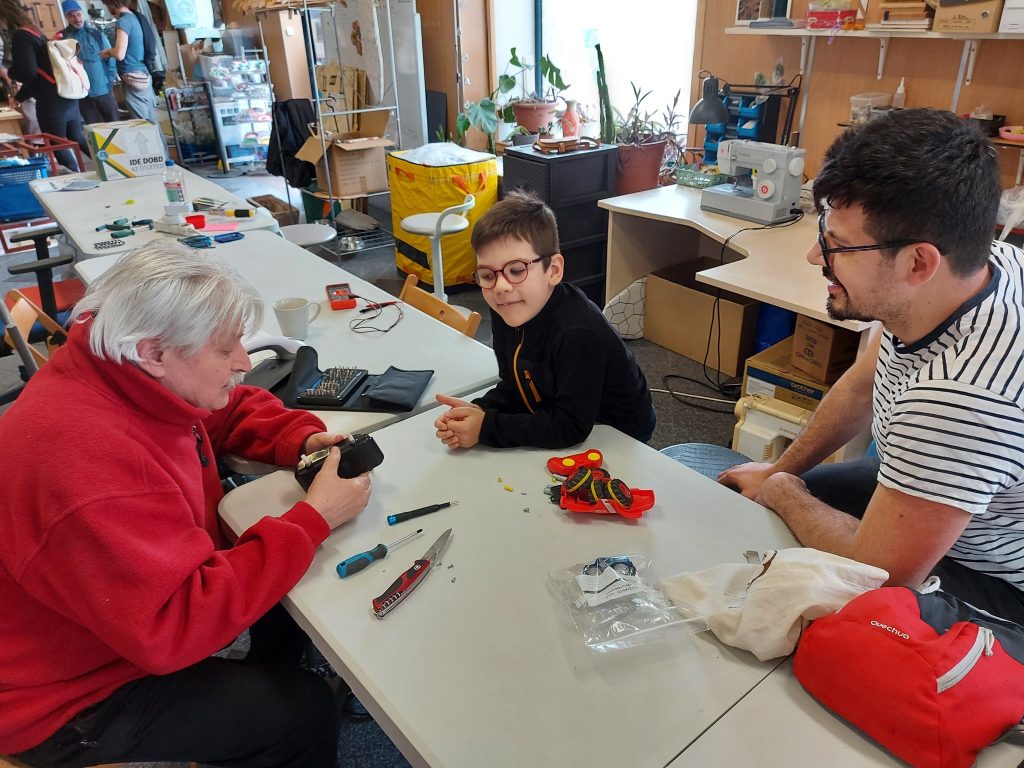
The neighbourhood is changing rapidly. There’s talk of reducing traffic, planting trees—various plans are being discussed. What do you hope this neighbourhood will look like in five years? And what concerns do you have if things aren’t handled thoughtfully?
Right now, there seem to be two main opinions about the area: some think it’s rapidly gentrifying, while others fear it’s becoming more of a slum. My main concern is that the people who currently live here—the original residents—will be pushed out. There are serious housing issues in the area, and I honestly don’t know how they’ll be solved.
Each part of this area is a bit different. Népszínház utca, the Palace Quarter, the Magdolna Quarter, and then going up towards Ludovika and behind Kálvária tér—they all face distinct challenges. But if I had to say what I’d really like to see in five years, firstly, I hope the current local leadership remains in place. They’re doing genuinely positive things right now, and it would be good if that could continue.
Building stronger connections among local organizations—like the homeless shelter and other civil groups—would also make a big difference. The more closely we can collaborate, the stronger the community’s social fabric becomes. But it’s crucial to involve local residents directly. Sometimes I see brainstorming sessions organised by people from entirely different parts of the city, without including residents from right here. That kind of brainstorming rarely gets to the heart of local issues.
What really matters to me is having conversations directly with the people who live here. For instance, people often come in and say things—sometimes racist comments, sometimes remarks about drug addiction, or homophobic slurs. When that happens, we try to have open discussions: What exactly is the problem? Why do you feel this way? What’s your personal experience behind these statements? It’s about helping people look outward, beyond their own immediate difficulties—even though I know that’s incredibly challenging when someone is already struggling at the bottom of the pyramid.
Interview by Levente Polyak and Sophie Bod

